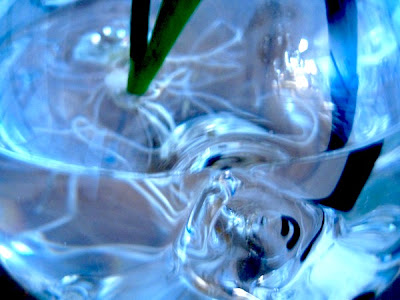In the same context, The Garden Lab at MassArt is an experimental project, a garden space and platform, where all students and the community-at-large can engage in an open conversation about art, design, food, community, and the environment. Under this umbrella, it hosted yesterday (March 14th) Photodotes (Light Donors) workshop as an opportunity to rethink living (and perhaps edible) structures, materials and the immaterial, light as energy, and the use of technology in architecture and gardens. The target of the intense, hands-on workshop was the collaborative construction of a hybrid structure/ 3d-garden that would consist of plants, fiberoptics, plastic containers, water and light.
Figure 01. Plants mixed with fiberoptics. Photo credits: Dominic Tschoepe
Figure 02. Photodotes: Light Garden at the end of the workshop. Photo credits: Dominic Tschoepe
The enthusiastic and extra-creative participants initially created and presented their personal sub-structures by sculpting the containers each one with different criteria or manifestos: to allow growth towards different directions, to follow the form and the intentions of the plant, to help the plant co-exist with other plants, to "force" symmetrical development, to create vertical planting, to change the functions were few of the ideas. Could these sculptures become new "bricks" towards the creation of a living (and perhaps edible) structure?
Figure 03. Rethinking materiality or possible new "brick"? Plastic containers (reused), water, roots, fiberoptics, light. Photo credits: Dominic Tschoepe
The hybrid structure, with the potential name "Light garden," has the special feature of bringing light in the roots via fiberoptics. This idea has emerged and developed during Zitofos (meaning Light Lives among many other things), a workshop that took place in Alexandroupolis, Greece during last summer in collaboration with MIT Art, Culture and Technology. Zitofos workshop has been the instigator of a research on spatial light that has been documented in the Zitofos platform. Part of the experimentation has been expressed in Photodotes I currently on show at Brant Gallery until May 7th.
Figure 04. Experiment to hypothesize how fiberoptics inserted in the water affect growth. Photo credits: Dominic Tschoepe
Figure 05. Refunctioning ingredients towards the making of a living wall. Photo credits: Dominic Tschoepe
Figure 06. Light inserted in the water via the fiberoptic cables in order to help the growth of the plant. Photo credits: Dominic Tschoepe
Figure 07. Participants scuptured the recycling containers in a unique way to allow plants to develop in multiple directions, to co-evolve, and to grow better. Photo credits: Dominic Tschoepe
Figure 08. Vertical growth of different plants. Photo credits: Dominic Tschoepe
Figure 09. Each plant is linked to at least one optic fiber that emits light at its end. Photo credits: Dominic Tschoepe
The second part of the workshop included the collaborative assembly of the individual garden clusters towards the creation of one "circular" garden-space. The collaborative character of the installation registered individual craftsmanship and signature expression of each author.
Figure 10. The "circular" garden-space or a possible living structure. Photo credits: Dominic Tschoepe
Figure 11. The happy result. Photo credits: Dominic Tschoepe
More info:
Zitofos platform on spatial light.
Project Credits:
Idea and project instigator: Zenovia Toloudi
Research: Zenovia Toloudi, George Toloudis, Ute Meta Bauer (MIT Art, Culture and Technology)
Photography: Dominic Tschoepe, Dimitris Papanikolaou, Zenovia Toloudi
Light Garden Collaborators: Dominic Tschoepe, Amir Banihashem, Dimitris Papanikolaou
Exhibition Curators: Evelyn Rydz, Jonathan Santos
Workshop assistants: Yamilah Kenny, Christian Keebler Restrepo
Participants: Lydia See, Brianna Dawes, Juliet Demasi, Colin Cardinal, Anika Catterfield, Georgia Kennedy, Julie Chen, Hayden Lemire
Note: This article was initially published at SHIFTboston, with the exception of Figure 11























